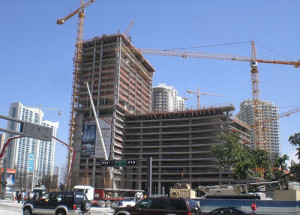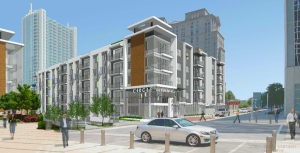Nationwide, developers are focused on building more mixed-use luxury multifamily developments such as this one, currently under construction in downtown Miami. Photo courtesy of Constec Developers.
Urban developers are counting on the demand for multifamily residences to stay strong over the next two to three years, and economists agree that developers have reason to be cautiously optimistic. Senior economist Ryan Severino of data firm Reis, Inc. says, “The problem is going to be on the supply side of the ledger, not the demand side.”
Excluding the nearly 100,000 government-sponsored affordable housing units built each year, the average number of new apartments over the last few years has leveled near the 120,000 mark. 230,000 will be completed by the end of 2015, with 197,000 more apartments coming available in 2016 and an additional 161,000 to be completed in 2017.
Of the development activity, Severino comments that “it seems like the floodgates have opened,” but “the new supply under construction completely outstrips the demand from [current] demographics.” By 2017, the apartments from 2015 and 2016 will have slackened the market a bit. The projected vacancy rate of about 5.5 percent will be a slight increase from the current vacancy rate of 4 percent.
However, Severino also says that the strong demand for apartments will persist over the next few cycles, helping to fill the new units coming available and ensure a renter pool for future units. The positive demographics that spurred the current multifamily boom will keep it rolling.
Lord, Aeck and Sargent are developing the luxury Circle Terminus residences in downtown Atlanta.
The timing for multifamily is also right, as 2017 will bring buyers back to the market with greater optimism and more cash to spend. It takes an average of ten years, according to Severino, for the market to recover from a major financial meltdown. During the decade afterwards, banks and individuals spend years paying off debts racked up by the boom before a recovery settles in. After six years of recovery, wages are slowly raising and inflation is stagnant, both of which indicate a greater likelihood of renters, rather than buyers, hitting the market in the coming years.
Nonetheless, for developers who are planning to enter the multifamily market in 2016, “it’s kind of late in the party, when all the punch is gone,” says Severino, “We always end up overdeveloping.” Although the demographic data and glacially paced economic recovery indicate that demand for apartments will remain high, the addition of hundreds of thousands of new mixed-use developments has already softened the multifamily market.
Mooreland Development’s Prosper West will soon be under construction in North Dallas. Photo courtesy of Mooreland Development.
Those who have recently joined the multifamily boom plan to avoid competition by building in markets and sub-markets that have lower rates of new construction. The majority of new development planned for 2017 will be high-end class-A condominiums and apartments located in central business districts. These communities will be competing with single-family homes rather than other apartment complexes. The remainder of development will be urban-adjacent along the city outskirts. The lower costs and less prime locations will cater to renters with lower incomes.



